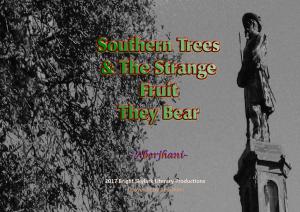Artwork by Aberjhani along with books by him will be available for purchase as part of his participation in Local Author Day on March 24, 2024, in Lafayette Square in the city of Savannah, Georgia (USA). Much of the artwork on display for the event will reflect themes explored in his books on Savannah.

One of the hardest questions posed by recent headlines in the U.S. has been: How do we come to terms in 2017 with legacies of an American past during which racism and other forms of social injustice were openly practiced? It's not a question that can be ignored because we're seeing so many of the results from it in the form of a rising number of hate groups and more overt promotions of fascist and nihilistic ideologies.
Several of my newest Postered Chromatic Poetics images examine the roots of some lot of the negativity--from racial tension and the economic divide to religious conflicts and the gender gap-- we're seeing now. They are less about shouting out accusations than about inviting reflections. The following are the text for them:
SOUTHERN TREES AND THE STRANGE FRUIT THEY BEAR (I)
I don't think Billie Holiday would mind me paraphrasing hers and Lewis Allen's famous song for the title of this image: Savannah's famous Confederate Monument as seen through curtains of gray Spanish moss hanging from the limbs of an oak tree in Forsythe Park.
Like many such monuments throughout the southern United States, notably the one recently removed from a public space in New Orleans, this one has been the subject of some controversy. You can't really tell by the angle used here but this is one of the largest Confederate monuments in the country.
The gentleman who posed for it was Civil War veteran Hamilton Branch.
SOUTHERN TREES AND THE STRANGE FRUIT THEY BEAR (II)
This is a variation on the first Southern Trees and the Strange Fruit They Bear.
Like many such monuments throughout the southern United States, notably the one recently removed from a public space in New Orleans, this one has been the subject of some controversy. You can't really tell by the angle used here but this is one of the largest Confederate monuments in the country. The gentleman who posed for it was Civil War veteran Hamilton Branch.
EUGENE TALMADGE MEMORIAL BRIDGE AND THE SERIOUS POLITICS OF NECESSARY CHANGE
A lot of articles have been written about why the name of the bridge spanning the Savannah River between the city and Hutchinson Island needs to be changed. Simply put: many feel it endorses white supremacy and ignores the obvious painful affront to Savannah's majority African-American population and its larger progressive diverse community.
During a 2016 "Span the Gap" initiative advocating for the change, a reporter named Janet Leigh Lebos asked for my input on the issue. The following is from her articled published in CONNECT SAVANNAH:
"Well, thus far it seems because the will of Savannah’s citizenry has been thwarted by the intimidation ploys of a few bullies—tactics familiar to Eugene Talmadge, who used them to oppress and abuse anyone he didn’t like. That’s what we’re memorializing unless we support our elected officials in getting this done already—not next session, not next election cycle.
"'It should not be necessary in 2016 to stage marches across the bridge or have sit-ins on it to disrupt the illusion, or delusion, of normalcy in order to bring about a crucial intelligent change,' counsels Aberjhani.
"It shouldn’t be necessary, but maybe that’s what it will take. It actually sounds pretty awesome: To climb to the apex of that two-mile marvel with our neighbors and friends as the giant ships sail beneath, hand in hand as we stand up in the name of connecting Savannah with the right side of history."
(Janet Leigh Lebos, CS, April 13, 2016, http://www.connectsavannah.com/savannah/name-shaming-the-talmadge-bridge/Content?oid=3432869 )
Aberjhani
May 2017